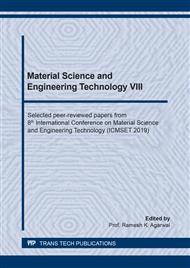[1]
Matos M, Pinho S, Tagarielli V. Predictions of the electrical conductivity of composites of polymers and carbon nanotubes by an artificial neural network. Scripta Materialia. 2019; 166: 117-21.
DOI: 10.1016/j.scriptamat.2019.03.003
Google Scholar
[2]
Shi L, Lin S, Lu Y, Ye L, Zhang Y. Artificial neural network based mechanical and electrical property prediction of engineered cementitious composites. Construction and Building Materials. 2018;174:667-74.
DOI: 10.1016/j.conbuildmat.2018.04.127
Google Scholar
[3]
Hoyos M, Garcia N, Navarro R, Dardano A, Ratto A, Guastavino F, et al. Electrical strength in ramp voltage AC tests of LDPE and its nanocomposites with silica and fibrous and laminar silicates. Journal of Polymer Science Part B: Polymer Physics. 2008;46:1301-11.
DOI: 10.1002/polb.21464
Google Scholar
[4]
Ubale SB, Deshmukh SD, Ghosh S. Artificial Neural Network based Modelling of Wire Electrical Discharge Machining on Tungsten-Copper Composite. Materials Today: Proceedings. 2018;5:5655-63.
DOI: 10.1016/j.matpr.2017.12.159
Google Scholar
[5]
Osman M.A, Rupp JEP, Suter U.W. Tensile properties of polyethylene-layered silicate nanocomposites. Polymer. 2005;46:1653-60.
DOI: 10.1016/j.polymer.2004.11.112
Google Scholar
[6]
Zazoum B, David E, Ngô A. LDPE/HDPE/Clay Nanocomposites: Effects of Compatibilizer on the Structure and Dielectric Response. Journal of Nanotechnology. 2013;(2013).
DOI: 10.1155/2013/138457
Google Scholar
[7]
Guo Y, Jiang S, Grena BJ, Kimbrough IF, Thompson EG, Fink Y, et al. Polymer composite with carbon nanofibers aligned during thermal drawing as a microelectrode for chronic neural interfaces. ACS nano. 2017;11:6574-85.
DOI: 10.1021/acsnano.6b07550
Google Scholar
[8]
Utracki L, Kamal M. Clay-containing polymeric nanocomposites. Arabian Journal Science & Engineering--special issue. 2002;27:43-67.
Google Scholar
[9]
Sharif MA, Lei H, Al-Rubaiai MK, Tan X. Ionic polymer-metal composite torsional sensor: physics-based modeling and experimental validation. Smart Materials and Structures. 2018; 27: 075039.
DOI: 10.1088/1361-665x/aac364
Google Scholar
[10]
Kornmann X, Lindberg H, Berglund LA. Synthesis of epoxy–clay nanocomposites: influence of the nature of the clay on structure. Polymer. 2001;42:1303-10.
DOI: 10.1016/s0032-3861(00)00346-3
Google Scholar
[11]
David E, Fréchette M, Zazoum B, Daran-Daneau C, Ngô AD, Couderc H. Dielectric properties of PE/clay nanocomposites. Journal of Nanomaterials. 2013;(2013).
DOI: 10.1155/2013/703940
Google Scholar
[12]
Morais M, Oliva-Avilés A, Matos M, Tagarielli V, Pinho S, Hübner C, et al. On the effect of electric field application during the curing process on the electrical conductivity of single-walled carbon nanotubes–epoxy composites. Carbon. 2019;150:153-67.
DOI: 10.1016/j.carbon.2019.04.087
Google Scholar
[13]
Montazer E, Salami E, Yarmand H, Chowdhury ZZ, Dahari M, Kazi SN, et al. Development of a new density correlation for carbon-based nanofluids using response surface methodology. Journal of Thermal Analysis and Calorimetry. 2018;132:1399-407.
DOI: 10.1007/s10973-018-6978-4
Google Scholar
[14]
Khan W.S, Hamadneh N.N, Khan W.A. Prediction of thermal conductivity of polyvinylpyrrolidone (PVP) electrospun nanocomposite fibers using artificial neural network and prey-predator algorithm. PloS one. 2017;12:e0183920.
DOI: 10.1371/journal.pone.0183920
Google Scholar
[15]
Şahin Y, Sahin S, İnal M. Modelling of the Tensile Properties of Calcium Carbonate Filled Polypropylene Composite Materials with Taguchi and Artificial Neural Networks. IFAC-PapersOnLine. 2018;51:282-6.
DOI: 10.1016/j.ifacol.2018.11.302
Google Scholar
[16]
Esfahani NN, Toghraie D, Afrand M. A new correlation for predicting the thermal conductivity of ZnO–Ag (50%–50%)/water hybrid nanofluid: an experimental study. Powder Technology. 2018;323:367-73.
DOI: 10.1016/j.powtec.2017.10.025
Google Scholar
[17]
Vallejo-Giraldo C, Pugliese E, Larrañaga A, Fernandez-Yague MA, Britton JJ, Trotier A, et al. Polyhydroxyalkanoate/carbon nanotube nanocomposites: flexible electrically conducting elastomers for neural applications. Nanomedicine. 2016;11:2547-63.
DOI: 10.2217/nnm-2016-0075
Google Scholar
[18]
Yousefi F, Karimi H, Mohammadiyan S. Viscosity of carbon nanotube suspension using artificial neural networks with principal component analysis. Heat and Mass Transfer. 2016;52:2345-55.
DOI: 10.1007/s00231-015-1745-6
Google Scholar
[19]
Zhang Z, Friedrich K. Artificial neural networks applied to polymer composites: a review. Composites science and technology. 2003; 63:2029-44.
DOI: 10.1016/s0266-3538(03)00106-4
Google Scholar
[20]
Wallace GG, Teasdale PR, Spinks GM, Kane-Maguire LA. Conductive electroactive polymers: intelligent polymer systems: CRC press; (2008).
DOI: 10.1201/9781420067156
Google Scholar
[21]
Bezerra E, Ancelotti A, Pardini L, Rocco J, Iha K, Ribeiro C. Artificial neural networks applied to epoxy composites reinforced with carbon and E-glass fibers: Analysis of the shear mechanical properties. Materials Science and Engineering: A. 2007; 464:177-85.
DOI: 10.1016/j.msea.2007.01.131
Google Scholar
[22]
Lefik M, Boso D, Schrefler B. Artificial neural networks in numerical modelling of composites. Computer Methods in Applied Mechanics and Engineering. 2009;198:1785-804.
DOI: 10.1016/j.cma.2008.12.036
Google Scholar
[23]
Marquardt DW. An algorithm for least-squares estimation of nonlinear parameters. Journal of the society for Industrial and Applied Mathematics. 1963; 11:431-41.
DOI: 10.1137/0111030
Google Scholar
[24]
Vogl TP, Mangis J, Rigler A, Zink W, Alkon D. Accelerating the convergence of the back-propagation method. Biological cybernetics. 1988;59:257-63.
DOI: 10.1007/bf00332914
Google Scholar
[25]
Rojas R. Neural Networks-A Systematic Introduction Springer-Verlag. New York. (1996).
Google Scholar
[26]
Pater L. Application of artificial neural networks and genetic algorithms for crude fractional distillation process modeling. arXiv preprint arXiv:160500097. (2016).
Google Scholar
[27]
Laredo E, Grimau M, Sanchez F, Bello A. Water absorption effect on the dynamic properties of nylon-6 by dielectric spectroscopy. Macromolecules. 2003; 36: 9840-50.
DOI: 10.1021/ma034954w
Google Scholar


